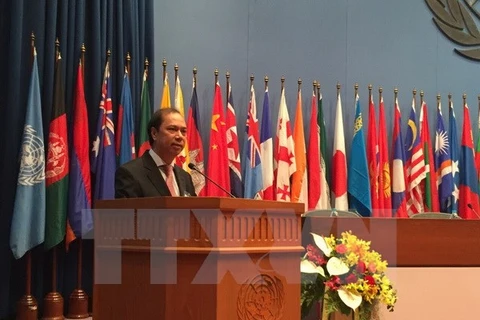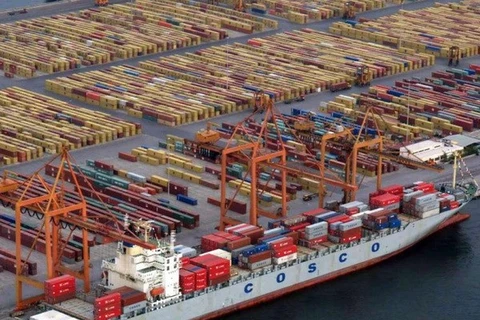 EU Trade Commissioner Cecilia Malmstrom (the sixth from the left) and ASEAN member nations' economic ministers at a meeting in Manila, the Philippines (Source:EPA/VNA)
EU Trade Commissioner Cecilia Malmstrom (the sixth from the left) and ASEAN member nations' economic ministers at a meeting in Manila, the Philippines (Source:EPA/VNA) In his article titled “ASEAN at 50: youth, technology and growth” recently published on Indonesia’s Jakarta Globe website, Wood gave a review of the group’s formation and development process, and its proud achievements over the last five decades.
The year 2017 sees ASEAN celebrating its 50th anniversary, which is also a moment to think about the future of the region and what lies ahead, it said, adding that the WEF on ASEAN in Phnom Penh, Cambodia in May this year will be just such a moment for reflection.
In recent years, ASEAN achieved remarkable achievements. The bloc as a whole has a good record in recent years, growing by around 5 percent a year, and powering the creation of a large middle class.
Early 2016, ASEAN became the seventh largest economy in the world. By the start of 2017, that rank had improved to sixth, and by 2020 it is expected to be the fifth.
“But, as impressive as this is, ASEAN could and should be growing much more quickly. A realistic aspiration is to grow at 7 percent”, the article stressed.
At 5 percent in growth, ASEAN doubles its income every 15 years, while at 7 percent it doubles every 10 years, it detailed.
According to Justin Wood, to achieve a growth target of 7 percent, the region must focus on many individual national issues, such as infrastructure and education.
The region would benefit significantly from pushing forward the implementation of the ASEAN Economic Community (AEC), he said.
He underlined the role plays by youth for the region’s development, and the need to ensure the quality of regional growth.
“The 630 million citizens of ASEAN are still extremely young, promising a powerful demographic dividend. As the working-age population grows in number, it will boost the region’s spending, but also increase its savings and hence its capacity to invest.”, he analysed.
Governments and policy-makers should ensure they pursue the right policies today to guarantee their demographic dividend is realised, think deeply about education and how best to prepare workers for the jobs of the future, and identify areas of inter-generational tension, such as the environment and the funding of pensions and healthcare, the article said.
Regarding technology, ASEAN is now the fastest growing internet market in the world, with the region’s online population expanding by 124,000 new users every day. This pace is forecast to continue in the next five years.
ASEAN must tackle difficult questions about how to navigate the accelerating pace of technological change and digital disruption if it wants to prosper for the next 50 years.
The Fourth Industrial Revolution could bring huge benefit to the region, driving financial inclusion, access to affordable healthcare, new forms of education, and the creation of new companies and service sector jobs.
However, technology could cause many challenges, so ASEAN member nations should focus on raising public awareness of IT and technology skills, and building the right enabling environment, and a connected regional digital economy, which enables the Fourth Industrial Revolution to thrive, the article stressed.
ASEAN groups Brunei, Cambodia, Indonesia, Laos, Malaysia, Myanmar, the Philippines, Singapore, Thailand and Vietnam.-VNA
VNA

























